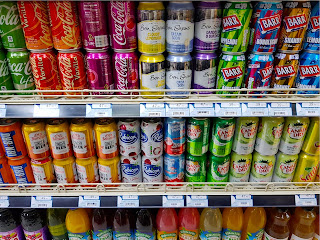What makes fizzy drinks taste fizzy?
What makes fizzy drinks taste fizzy?
When carbon dioxide gas and
water react, they produce a weak acid, called carbonic acid. Carbonic acid is
what is in your soda or any drink with bubbles. Carbonic acid stimulates the
same taste receptors as the ones that are triggered by cinnamon and mustard and
it is what gives rise to that prickly sensation in your mouth. If you have ever
heard your dentist mention to you that it is the soda that you drink that is
ruining the enamel on your teeth, take comfort in the fact that it is not
carbonic acid that is the culprit. Hint: It is Red Bull that is the worst offender.
Carbonic acid has a pH of 4.2, giving carbonated water a pH of 4.5. This is
slightly acidic, but certainly not as acidic as Red Bull, which is 3.3.
Where can you find carbonic acid?
The first place you can find
it, is in you! Carbon dioxide is present in the blood and combines with water to
form carbonic acid, which is exhaled as a gas by the lungs. The rate of your
respiration determines the amount of carbon dioxide exhaled. If your rate of
breathing increases, less acid is in the blood. If the rate decreases, the
blood becomes more acidic. This is called the carbonic acid bicarbonate buffer
system.
If carbon dioxide gas and water react, to make carbonic acid, is this
a reaction that occurs with ocean water and the carbon dioxide from the atmosphere?
Yes! The oceans can absorb
large amounts of carbon dioxide from the atmosphere. This is a similar buffering
system to the one just mentioned. Unlike the process in your body, this process takes 1,000 to 100,000
years for the entire ocean system to become buffered. Because of the rising
amounts of carbon dioxide caused from burning fossil fuels, the ocean’s pH is
increasingly more acidic, a term referred to as ocean acidification.



References
ReplyDeleteDessirler, J., Simons, C., Caratens, M., O’mahony, M., & Carstens, E. (2000). Psychophysical and neurobiological evidence that the oral sensation elicited by carbonated water is of chemogenic origin. Chemical Senses, 25(3), 277–284. https://doi.org/10.1093/chemse/25.3.277
Owens B. M. (2007). The potential effects of pH and buffering capacity on dental erosion. General dentistry, 55(6), 527–531.
Team Dental. (2017, February, 9) https://www.team-dental.co.nz/blog/are-energy-drinks-bad-for-your-teeth/
BC Campus. (n.d.). Acid base balance. Pressbooks. https://opentextbc.ca/anatomyandphysiologyopenstax/chapter/acid-base-balance/
Timescavengers. (n.d.) Ocean chemistry & acidification. Word Press. https://timescavengers.blog/climate-change/ocean-chemistry-ocean-acidification/
Nguyen, D. (2018, March 9). Acid Rain Basics. Sciencing. https://sciencing.com/acid-rain-affect-buildings-statues-22062.html
Image: https://www.shutterstock.com/image-photo/bangkok-th-february-14-2018-various-1056011909